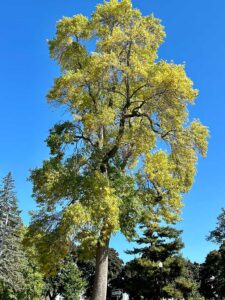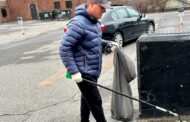We can help expand Portland’s urban tree canopy by bringing air and water to its roots
By Nancy English
A summer city walk under the shifting shadows of leaves transforms time with natural magic. And the enchantment starts at the roots of trees. Biologists are still exploring these symbiotic processes. But we do know how to help nourish and water those roots, as Portland Arborist Mark Reiland explained, with mulch, aeration, and organic matter.
West Enders have adopted street trees for special attention, clearing tree pits of weeds, tucking perennials into place, and spreading mulch. On May 3rd, from 2 to 4 p.m., free mulch and information will be on offer at Taylor Street Park – along with a list of tree pits that can use care – for any new volunteers in the West End, Parkside, St. John Valley, Libbytown, and the Western Promenade neighborhoods.
“The glaring result of [citywide] soil testing,” Reiland said, is that “soils are depleted of organic matter.” As a consequence, our lately abundant rains never penetrate to the roots. The soils are heavily compacted. “The soil is dry at six inches below the surface. Rain is just sheeting off the surface.”
The City of Portland Parks staff will be rolling shatter tine aerators across park land to penetrate the compacted top layer of soil. Oxygen and rainfall and organic matter in compost will then have a chance to sink deeply into the soil.
Longer Seasons and the Emerald Ash Borer

Over the last 50 years, our area’s growing degree days (GDD) have increased by 25 percent, Reiland said. This calculation measures plants’ growing seasons, beginning earlier and ending later every year. Unfortunately, along with the trees and plants, insects are also flourishing.
The emerald ash borer is rapidly killing many of the city’s 650 to 700 street ash trees. Its larvae eat the vital tissue under the trees’ bark. The city removes the dying trees but is also fighting the insects in around 200 ash trees treated biannually. Identify these specimens by a purple disk set high up in the tree trunk.
An upcoming sewer separation and water main replacement project near Fessenden Park will be the site of structural soil installation in a “root corridor” allowing a tree’s roots to travel from an esplanade into the richer territory of a private yard. And meanwhile the City will continue its annual planting of 140 to 150 trees, giving them the best soil they can in the confines of a sidewalk tree well.
It’s time we all learn to become better custodians of our trees.





